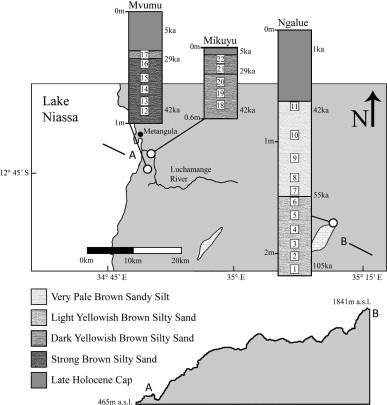Julio Mercadera, Tim Bennetta, Chris Esselmontb, Steven Simpsona, Dale Waldea
Source - http://www.sciencedirect.com/science/article/pii/S0047248413000353
Journal of Human Evolution, Volume 64, Issue 5, May 2013, Pages 328–336
Abstract
The detection of areas suitable for hominins during late Pleistocene drought intervals is currently a priority for Middle Stone Age research. Predicting the location of populations and dispersal pathways through the East African Rift System during the last glacial phase is a challenging task due to scarce direct archaeo-vegetation data. We present a Mozambican phytolith record spanning 105–29 ka and argue for the necessity and utility of using local plant microbotanical data from archaeological sites to understand the past environments in which early modern humans lived. We assess biome structure, spatial variability, and compare phytolith-based to lacustrine environmental reconstructions to conclude that dense wooded landscapes dominated the area over much of the last glacial phase. Archaeological and botanical data suggest the hypothesis of a palaeodispersal along a montane woodland archipelago that could have attracted hominin settlement and facilitated dispersals through an inland bridge that connected southern, central and East Africa, and the two branches of the East African Rift System.

Figure 1. Map of the study area across a geographical, altitudinal, climatic, and botanical gradient in the Niassa Rift, Mozambique. Three sites were excavated: one in the highlands (Ngalue) and two in the lowlands (Mikuyu and Mvumu). Sedimentological data, column phytolith provenance, and sample labels are shown. The terrain cross section reflects the local relief from the shore line (A) to Mount Geci (B).

Figure 2. Fossil phytoliths: globular granulate (a, b Mvumu 12; c, d Ngalue 4); globular psilate (e Ngalue 2); blocky (f Mvumu 14; g Mvumu 12; h Ngalue 2; i Mvumu 12); tabular thick dendritic cf. Kigelia Africana (Mercader et al., 2009b) (j Ngalue 5); clavate granulate cf. Monotes spp. (Mercader et al., 2009b) (k Mikuyu 20; l Mvumu 12); globular echinate (m Mikuyu 20; n Mvumu 14); lobate (o Ngalue 8; p, q Ngalue 9); polylobate (r Mvumu 12); saddle, long (s Ngalue 4; t Mikuyu 19; u-w Mvumu 12); bulliform cf. Oxytenanthera abyssinica (Mercader et al., 2010) (x Mvumu 17); epidermal polygonal (y Ngalue 9); perforated plate (z Ngalue 3); achene/hat shape from sedges (aa, ab Ngalue 6; ac Ngalue 9); tabular thick pilate (ad Ngalue 3); Vessel member (ae Ngalue 5); saddle, short (af, ag Ngalue 10).